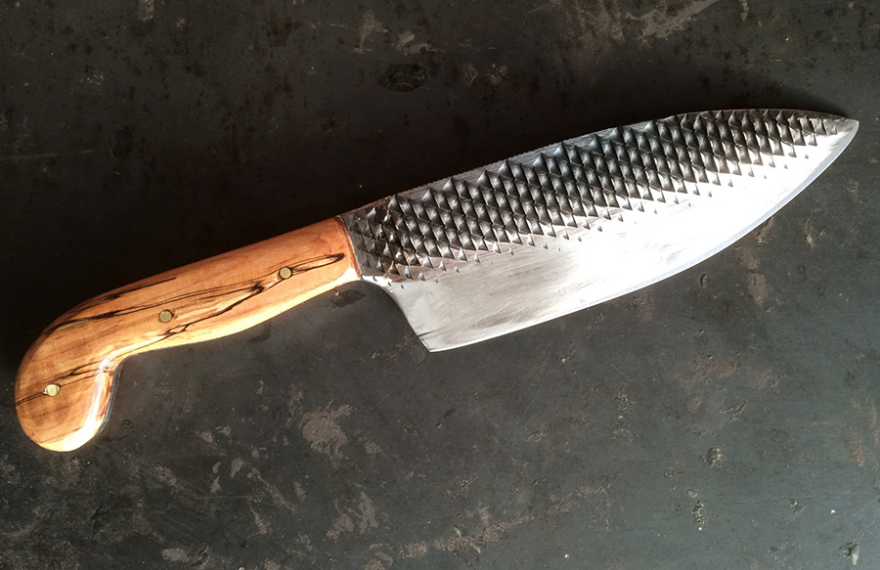
Chelsea Miller's Unusual Kitchen Knife Designs
Growing up on a farm has its advantages
Finding success as a maker is never easy, but if you can find the right niche and execute your craft well, you've got a shot. And it's fair to say Chelsea Miller's got a shot.
 Enter a caption (optional)
Enter a caption (optional)The knifemaking Miller started out just four years ago, and according to Bloomberg is now back-ordered for six to eight weeks and puts in seven days a week at her Brooklyn shop to meet orders. Miller's product is unusual: She makes kitchen knives from reclaimed horse-grooming tools.
 Enter a caption (optional)
Enter a caption (optional)Under Miller's torch and grinding machines, a former Farrier's rasp becomes a chef's knife, the teeth left intact, the non-cutting edge left serrated for what utility they might offer; Miller uses the rough surfaces to grate cheese and garlic in her test kitchen.
 Enter a caption (optional)
Enter a caption (optional) Enter a caption (optional)
Enter a caption (optional)What's interesting is that Miller began learning to make knives as a way of connecting with her father, a blacksmith and carpenter, who had fallen ill in 2010; upon returning to the family farm she picked up the craft working with her father and brother. Initially she gave them to friends as gifts, but those friends eventually pushed her to begin selling them at the Brooklyn Flea, which she did, years ago, for $200; demand being what it is, at present day the chef's knives sell for $800, with the smallest cheese knife being the entry-level at $200.
 Enter a caption (optional)
Enter a caption (optional) Enter a caption (optional)
Enter a caption (optional) Enter a caption (optional)
Enter a caption (optional) Enter a caption (optional)
Enter a caption (optional)You may be wondering: Are the knives any good, would a pro chef use them? We have to say she's received a rousing endorsement: New York's famous Eleven Madison Park has placed an order with her.
 Enter a caption (optional)
Enter a caption (optional) Enter a caption (optional)
Enter a caption (optional)Filmmaker Andrew Baker of Airfield Films is currently working on a documentary featuring Miller called "Beekeeping on Pluto." Here's the teaser:
Via Artnau
-
oFavorite This
-
Q8Comment
K
{Welcome
Create a Core77 Account
Already have an account? Sign In
By creating a Core77 account you confirm that you accept the Terms of Use
K
Reset Password
Please enter your email and we will send an email to reset your password.


Comments
This is all about marketing and nothing to do with a well designed, quality product.
People have been making knives from rasps for decades...check out the Facebook group..."making knives from files and rasps." Her knives are so amateur as to be embarrassing. Knifes like [much better] then hers usually sell between $100 to $150.As a professional knife maker I constantly hear jokes about her...A primitive knife like hers takes a couple of hours at the most to make...I guess in a world where people pay extra for jeans with holes her stuff makes sense....In the real world anyone paying $800 for one of her knives is getting ripped off.
Love the creativity and craftsmanship! Sorry to say that as educated some people think there are, they simply haven't learned the simplest things as "if you have nothing nice to say then don't say anything at all", or "treat others as you want to be treated". Our society has given us a new breed of creatures who just go on the internet to be mean and share their misery with others by commenting on people who are actually doing something with themselves. More power to you and I hope to see more of your work! Aloha!
The fit and finish looks pretty rough, you can get much higher quality, better functioning hand made knives for less money. It is a great triumph of marketing that she manages to sell these knives for $800, but fair play to her.
Very nice craft work, but I think it's a bad idea combining the tools. The back and forth grating motion seems like it could be dangerous if someone were to go off center toward the blade while swinging their fingers back and forth in the grinding motion.
Beautiful, but seems like most of these would be painful to use if you accept proper knife skill means holding the knife in your dominant hand, the food in your non-dominant, and allowing the knife blade to slide on the knuckles of your non-dominant hand. Maybe the ground edge extends high enough on some that it's not an issue?
These are awesome, and I love her use of unique woods on the handles, but I feel that its worth mentioning that Peace Knives' Remanant series deserves at least a hat tip for being the groundbreaker on this concept.
Using files and rasps for knifemaking is nothing new, they are good-quality tool steel, and can be tempered to hold a good edge. Leaving the hasp teeth visible is cool-looking (reminiscent of the kurouchi hammer marks on some Japanese cutlery), but seems like it would hard get clean and dry - and these will be very prone to rusting, high-carbon, non-stainless steel needs to be cared for.